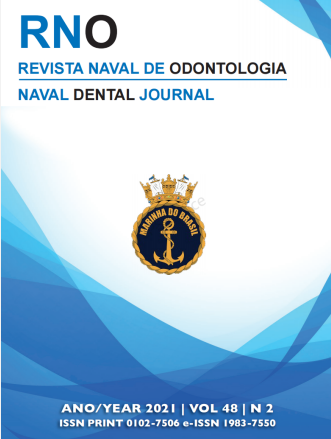PERIODONTAL PHENOTYPE : REVIEW
Keywords:
Periodontal phenotype, gingival phenotype, gingival biotype.Abstract
One of the essential elements to achieve smile aesthetics is the phenotype and gingival contour, which with its architecture influences the size of dental crowns. The term “periodontal phenotype” was standardized at the 2017 workshop, but much has already been said about the topic, with other nomenclatures. The evaluation of different periodontal phenotypes is essential, as they give us information related to the characteristics of periodontal tissues and dental forms. In addition to making treatment more predictable, it can prevent trauma, inflammation and other clinical and surgical complications. There are several ways to diagnose the periodontal phenotype, the one advocated by the 2017 workshop, the transparency of the gingival sulcus through the millimeter probe. We can observe a prevalence of the thin phenotype by the female sex, whereas the thick phenotype by the male sex. More scientific evidence is still lacking for the corrective relationship between the periodontal phenotype and other factors such as age, smoking, hygiene habits, diet and malocclusion.
References
(2)Morley J, Eubank J. Macroesthetic elements of smile design. J Am Dent Assoc. 2001;132 ;39-45.
(3)Obradovic-Djuricic, Kostic L, Martinovic Z. Gingival and dental parameters in evaluation of esthetic characteristics of fixed restorations. Srp Arh Celok Lek. 2005;133(3-4);180-7.
(4) Kao RT, Pasquinelli K, Thick Versus Thin Gingival Tissue: A Key Determinant in Tissue Response to Disease and Restorative Treatment. Journal of the California Dental Associaton, California, jul 2002, vol.30 n.7, p. 521-525.
(5) Jepsen S, Caton JG, Albandar JM, et al. Periodontal manifestations of systemic diseases and developmental and acquired conditions: consensus report of workgroup 3 of the 2017 world workshop on the classification of periodontal and peri-implant diseases and conditions. J Periodontol. 2018;89:237-248.
(6) Kao RT, Fagan MC, Conte GJ. Thick vs thin gingival biotypes: a key determinant in treatment planning for dental implants. Journal of the California Dental Association. 2008;36:193–98.
(7) Lima LA. Estética em periodontia: quais os fatores que limitam a possibilidade dos resultados? In: Lotufo RFM, Lascala Jr NT. Periodontia e Implantodontia: desmistificando a ciência. 2003; Cap.15
(8) Ronay V, Sahrmann P, Bindl A, Attin T, Schmidlin PR. Current status and perspectives of mucogingival soft tissue measurement methods. J Esthet Restor Dent. 2011;23:146-156
(9) Alves PHM, Alves TCLP, Pegoraro TA, Costa YM, Bonfante EA, de Almeida ALPF. Measurement properties of gingival biotype evaluation methods. Clin Implant Dent Relat Res. 2018; 00:1–5
(10) Harris RJ. A comparative study of root coverage obtained with guided tissue regeneration utilizing a bioabsorbable membrane versus the connective tissue with partial-thickness double pedicle graft. J Periodontol. 1997;68:779-790.
(11) Kan JY, Rungcharassaeng K, Umezu K, Kois JC. Dimensions of periimplant mucosa: an evaluation of maxillary anterior single implants in humans. J Periodontol. 2003;74:557-562.
(12) Müller HP, Heinecke A, Schaller N, Eger T. Masticatory mucosa in subjects with different periodontal phenotypes. J Clin Periodontol. 2000;27:621-626
(13) Müller HP, Eger T. Gingival phenotypes in young male adults. J Clin Periodontol. 1997;24:65-71
(14) Januário AL, Barriviera M, Duarte WR. Soft tissue cone-beam computed tomography: a novel method for the measurement of gingival tissue and the dimensions of the dentogingival unit. J Esthet Restor Dent. 2008;20:366-373.
(15) De Rouck T, Eghbali R, Collys K, et al. The gingival biotype revisited: transparency of the periodontal probe through the gingival margin as a method to discriminate thin from thick gingiva. J Clin Periodontol. 2009;36:428-433.
(16) Eghbali A, De Rouck T, De Bruyn H, Cosyn J. The gingival biotype assessed by experienced and inexperienced clinicians. J Clin Periodontol. 2009;36:958-963
(17) Kan JY, Marimoto T, Rungcharassaeng K, Roe P, Smith DH. Gingival biotype assessment in the esthetic zone: visual versus direct measurement. Int J Periodontics Restorative Dent. 2010;30:237-243.
(18) Fu JH, Yeh CY, Chan HL, Tatarakis N, Leong DJM, Wang HL. Tissue biotype and its relation to the underlying bone morphology. J Periodontol. 2010;81:569-574
(19) Zweers J, Thomas RZ, Slot DE, Weisgold AS, van der Weijden FGA. Characteristics of periodontal biotype, its dimensions, associations and prevalence: a systematic review. J Clin Periodontol. 2014;41:958-971.
(20) Cook DR, Mealey BL, Verrett RG, et al. Relationship between clinical periodontal biotype and labial plate thickness: an in vivo study. Int J Periodontics Restorative Dent. 2011;31:345-354.
(21) Fischer KR, Künzlberger A, Donos N, Fickl S, Friedmann A. Gingival biotype revisited-novel classification and assessment tool. Clin Oral Investig. 2018;22:443-448.
(22) Kim DM, Bassir SH, Nguyen TT. Effect of gingival phenotype on the maintenance of periodontal health: an American Academy of periodontology best evidence review. J Periodontol. 2020;91: 311-338.
(23)“Phenotype.” Merriam-Webster.com Dictionary, Merriam-Webster, https://www.merriam-webster.com/dictionary/phenotype. Accessed 28 Feb. 2021.
(24) Lindhe J. Tratado de Periodontia Clínica e Implantodontia Oral. 4a ed. Rio de Janeiro : Guanabara Koogan ; 2005.
(25) Amid R, Mirakhori M, Safi Y, Kadkhodazadeh M, Namdari M. Assessment of gingival biotype and facial hard/soft tissue dimensions in the maxillary anterior teeth region using cone beam computed tomography. Arch Oral Biol. 2017 Jul;79:1-6.
(26) Maroso FB, Gaio EJ, Rösing CK, Fernandes MI. Correlation between gingival thickness and gingival recession in humans. Acta Odontol Latinoam. 2015;28(2):162-6.
(27) Karakış Akcan S, Güler B, Hatipoğlu H. The effect of different gingival phenotypes on dimensional stability of free gingival graft: A comparative 6-month clinical study. J Periodontol. 2019 Jul;90(7):709-717.
(28) Yuan J, Guo QQ, Li Q, Sui YJ, Jiang BQ. Relationships among the periodontal biotype characteristics in the maxillary anterior. Hua Xi Kou Qiang Yi Xue Za Zhi. 2020 Aug 1;38(4):398-403.
(29) Yin XJ, Wei BY, Ke XP, Zhang T, Jiang MY, Luo XY, Sun HQ. Correlation between clinical parameters of crown and gingival morphology of anterior teeth and periodontal biotypes. BMC Oral Health. 2020 Feb 19;20(1):59.
(30) Egreja AM, Kahn S, Barceleiro M, Bittencourt S. Relationship between the width of the zone of keratinized tissue and thickness of gingival tissue in the anterior maxilla. Int J Periodontics Restorative Dent. 2012 Oct;32(5):573-9.
(31) Müller HP, Schaller N, Eger T. Ultrasonic determination of thickness of masticatory mucosa: a methodologic study. Oral Surg Oral Med Oral Pathol Oral Radiol Endod. 1999 Aug;88(2):248-53.
(32) ARAÚJO Lidya Nara Marques de, BORGES Samuel Batista, MEDEIROS Isadora, AMORIM Ana Carolina de Melo, BARBOSA Carolina Valcacio, GURGEL Bruno César de Vasconcelos. Determinação do biótipo periodontal através da análise de fotografias intra-orais. Rev. odontol. UNESP [Internet]. 2018 Oct [cited 2021 Feb 28] ; 47( 5 ): 282-290.
(33) Gkogkos A, Kloukos D, Koukos G, Liapis G, Sculean A, Katsaros C. Clinical and Radiographic Gingival Thickness Assessment at Mandibular Incisors: an Ex Vivo Study. Oral Health Prev Dent. 2020 Jun 8;18(1):607-617.
(34) Aguilar-Duran L, Mir-Mari J, Figueiredo R, Valmaseda-Castellón E. Is measurement of the gingival biotype reliable? Agreement among different assessment methods. Med Oral Patol Oral Cir Bucal. 2020 Jan 1;25(1):e144-e149.
(35) Manjunath RG, Rana A, Sarkar A. Gingival Biotype Assessment in a Healthy Periodontium: Transgingival Probing Method. J Clin Diagn Res. 2015 May;9(5):ZC66-9.
(36) Rathee M, Rao PL, Bhoria M. Prevalence of Gingival Biotypes among Young Dentate North Indian Population: A Biometric Approach. Int J Clin Pediatr Dent. 2016 Apr-Jun;9(2):104-8.
(37) Joshi A, Suragimath G, Zope SA, Ashwinirani SR, Varma SA. Comparison of Gingival Biotype between different Genders based on Measurement of Dentopapillary Complex. J Clin Diagn Res. 2017 Sep;11(9):ZC40-ZC45.
(38) Alkan Ö, Kaya Y, Alkan EA, Keskin S, Cochran DL. Assessment of Gingival Biotype and Keratinized Gingival Width of Maxillary Anterior Region in Individuals with Different Types of Malocclusion. Turk J Orthod. 2018 Mar;31(1):13-20.
(39) García-Cortés JO, Loyola-Rodríguez JP, Monárrez-Espino J. Gingival biotypes in Mexican students aged 17-19 years old and their associated anatomic structures, socio-demographic and dietary factors. Journal of Oral Science. 2019. 61(1):156-163.
(40) Rathod SR, Gonde NP, Kolte AP, Bawankar PV. Quantitative analysis of gingival phenotype in different types of malocclusion in the anterior esthetic zone. J Indian Soc Periodontol. 2020 Sep-Oct;24(5):414-420.













